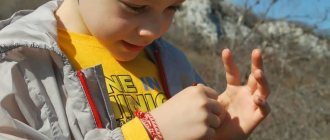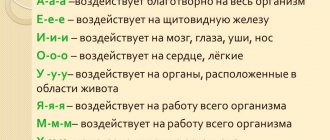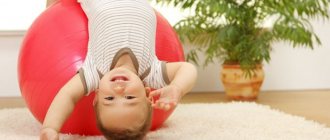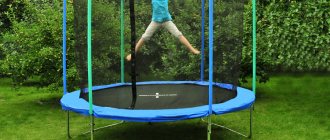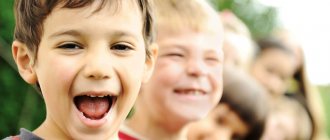In the lower grades, special attention is paid to the development of children's fine motor skills, imagination, and thinking. Gymnastics for fingers in elementary school helps the hands become obedient, which is necessary for performing precise movements in the visual arts and writing. By repeating the teacher’s movements, students activate their motor skills, develop the ability to concentrate and control movements. Before starting activities that parents can easily conduct even at home with a 7-8 year old child, it is recommended to study all the features and rules of exciting lessons.
Finger gymnastics for primary school
Finger games, which are so popular with children aged 7-8, are an activity that can significantly improve their skills. Scientists have found that hand movements are directly related to the cerebral cortex, which promotes development.
In elementary school, finger exercises are a prerequisite that allows children to take a break from unusual workload, get a boost of energy, and relax. There are many exercises that are complemented by funny rhymes, even songs that have a certain meaning - they contribute to the development of speech, a sense of rhythm, and vocabulary.
Despite the benefits of finger exercises, you should also not overuse interesting games. The duration of one lesson should not exceed a quarter of an hour, and it is better to start with short lessons - just a few minutes.
MAGAZINE Preschooler.RF
“Finger gymnastics as a means of speech development for preschool children”Bolotova Natalya Viktorovna Teacher-speech therapist of the highest qualification category MBDOU "Kindergarten of compensatory type No. 17" Sergiev Posad municipal district Moscow region, Sergiev Posad,
annotation
This article examines the relevance and usefulness of finger games as a means of speech development during correctional and educational work in preschool institutions. The purpose, tasks of finger gymnastics, and the rules for its implementation are described. Examples of finger games for classes with children, “tied” to the study of lexical topics for the 1st period of study (September-November) are given.
Topic: “Finger gymnastics as a means of speech development for preschool children”
The popularity of finger games has increased significantly. Such games are not a newfangled hobby for modern parents. They have existed among different peoples since ancient times. And no wonder, because finger games are a wonderful way to cheer up a child, distract him from something, and find contact with any child.
The development of the motor side of speech depends not only on the functional capabilities of the facial-articulatory muscles directly involved in the implementation of speech acts; The development of a child’s speech is also indirectly related to the state of his general motor skills, i.e. motor activity in general.
Previously, it was believed that the main thing on which speech development depends is the degree of verbal communication between children and surrounding adults. However, research by scientists has shown that the degree of verbal communication with adults does not play as big a role as expected. They also studied the relationship between a child's speech ability and his motor functions. Studying the anatomical relationships of the child’s body, scientists, neuropathologists and defectologists came to the conclusion that the child’s speech ability depends not only on the training of the articular apparatus, but also on the movements of the fingers. The hand can be classified as a speech apparatus, and the motor projection area of the hand can be classified as
What is it for?
The main goal of finger exercises is to develop fine motor skills. With regular exercise, the benefits for children are undoubted, because at the same time they improve:
- accuracy and dexterity;
- fantasy, thinking;
- memory, speech;
- concentration of attention;
- Creative skills.
Exercises in grade 2 also allow students to take a break from prolonged drawing and writing. Simple hand movements relieve muscle tissue fatigue and prevent finger spasms, which often happens in children whose hands are not accustomed to prolonged stress.
Finger gymnastics in physical education lessons
Borisov Sergey Vladimirovich, physical education teacher, MBOU "Kozmogorodskaya Basic School of the Mezensky District" of the Arkhangelsk Region. Kozmogorodskoe.
One of the most expressive means of communication is human hands. They characterize a person’s personality, and they can be used to determine a person’s profession. If a person has well-developed hand plasticity, then the hands are mobile, elastic, and flexible. There are special exercises for developing hand plasticity. Such exercises are useful for children of any age, starting from preschool. They can be included in games, morning hygienic exercises, physical education lessons, physical education lessons and other activities included in the school day. To form a child’s personality, exercises to develop strength, speed, and manual dexterity are important. Children with poor hand coordination draw worse and have difficulty in physical education and technology lessons. Their overall coordination of movements is insufficiently developed. Therefore, it is very important to start developing strength, speed and agility in children in a timely manner. In finger gymnastics, there are also muscle relaxation exercises. To learn how to relax muscles, you need to master special skills. You need to start with simple and easy exercises.
Finger gymnastics exercises teach a child to concentrate attention and distribute it correctly. This is a very, very important skill! His school success largely depends on this skill. Exercises also make the child’s speech clearer, more rhythmic, and brighter. In addition, he will be able to increase control over his movements. In finger games you need to remember a lot: the position of the fingers, the sequence of movements, and just poetry. Here's a great fun exercise for developing your child's memory!
With the help of finger games, fantasy and imagination will develop. After all these exercises, your hands and fingers will become strong, mobile, and flexible. And this will help in the future in mastering the skill of writing!
How much and how often should you do finger gymnastics ? Any exercise is effective only if done regularly. So finger games (exercises) will bring effect during regular exercise, for example, in physical education lessons during warm-up. Younger schoolchildren really like these exercises!
Exercises to develop plastic movements
- Wave. I.p. - arms are bent forward, palms down. Perform wave-like movements with your palms, then with your arms as a whole. Consistently bend and straighten your arms at all joints.
- Jellyfish. I.p. – arms are bent, palms down, fingers apart. Imitating the movements of jellyfish tentacles with your fingers.
- Fan. I.p. – arms bent forward to the sides, palms forward, fingers spread as far apart as possible. First, press your thumb to your palm, and then successively press the rest. After this, straighten your fingers in the reverse order.
- Conducting – with the brush of the right and left hands alternately. Then perform the movements with both hands.
- Let's paint. Imitation of painting objects with a brush. The palm performs relaxed movements from top to bottom, top to bottom, left to right and right to left.
- Throw a snowball. Simulation of a snowball fight. Simulates making a snowball and throwing a snowball at a target.
- Claws. I.p. –arms bent at the elbows, hands in front of the chest, palms facing down, fingers spread wide and extended to the limit. Slowly bend your fingers, clenching them into a fist, and then slowly straighten them to the point. You need to bend your fingers as if they were the claws of a bird of prey.
Exercises to develop strength.
- Tense extension of the fingers and clenching of the hand into a fist.
- I.p. – hands into fists. Tense extension of fingers with fingers apart
- Squeezing a hand dynamometer, a rubber ring, or a rubber ball with your fingers.
- I.p. – hands in front of the chest, palms joined together. Raising, lowering, rotating tense hands with stops and without stops in intermediate positions.
- Raising, lowering, rotating hands clenched into fists.
- I.p. – hands in front of the chest, fingers clasped. Stretch your arms to the sides: 2 – 3 sec. - stretching, then 2-3 sec. rest.
- While standing (lying down), bent over, rise onto your fingers and lower onto your entire palm.
Flexibility exercises
- Spring abductions of the palm of the right hand with the left hand.
- Springy abductions of the palms joined together, fingers apart. First press your right palm onto your left, and then vice versa.
- Turn the hands in and out.
- IP - hands in front of the chest, palms facing the chest, fingers clasped. Extend your arms forward with springy movements, pointing your palms forward.
- While standing on your knees, spring forward swaying, do not lift your palms from the floor.
- The same as the previous exercise, but in a support position lying behind.
- I.p - hands forward. Raising your palms up and lowering them down; abduction of palms to the sides; circles with brushes; circles with each finger in greater amplitude; circles with your fingers forward, straightening and bending them.
- I.p. – hold the stick horizontally between the little and index fingers: 1 – bending the ring and middle fingers, move the fingers forward under the stick; 2 – do the same in the opposite direction. After the exercise has been learned, you can begin to perform its other variations.
- I.p. – stand with your feet apart, hands in front of your chest, fingers clasped. Perform movements with your hands, depicting a figure eight.
- I.p. – hands in front of the chest, press your palms together with your fingers up. Try to raise your elbows higher without lifting your palms away from each other.
Literature:
- Magazine “Physical Education at School”, No. 5, No. 6, 2011, “Exercises for finger gymnastics” (V.R. Beilin, A.A. Beilina).
Internet resources:
- https://www.ot1do3.ru/
- https://nsportal.ru/nachalnaya-shkola/logopediya/2012/04/02/palchikovaya-gimnastika-dlya-mladshikh-shkolnikov
Exercises
Teachers should remember that it is better to start with one or two exercises, allowing the child to learn the characteristics of each movement. It is recommended to conduct activities before and after class.
"Ring"
Finger movements allow you to relax tired muscles, rest, and improve motor skills.
Step-by-step exercise:
- Connect the thumb with the others.
- Be sure to ensure that even “rings” are formed.
- Carry out the exercise alternately on one and the other hand.
- Connect the fingers of both hands at the same time.
During the lesson, you can say any counting rhyme - this helps the child develop rhythm.
“Fist, palm, rib”
Another set of gymnastic movements that contributes to the development of primary school students.
Carrying out:
- Clench your fists and lightly tap on the surface of the desk.
- Unclench your fists and tap on the desk with the edge of your palm.
- Change the position of your hand and tap the surface with your palms.
It is not recommended to make sharp jerks - relaxing, smooth movements of the hands will bring benefits.
https://youtu.be/1b3ItMqYDGE
"Noughts and Crosses"
You can turn a simple activity into a fun game for children. The main thing is to understand that a zero is crossed fingers (middle finger with index finger). Zero - connected pads of the thumbs and ring fingers.
Now the children just have to follow the teacher’s commands and reproduce the necessary figures. You can even have a competition to see who can respond first and draw a cross or a zero. Over time, complicate the exercise - alternate the ring and middle fingers, start with movements of the left or right hand, finish with both at the same time.
"Fish"
Putting your palms together is a nimble “fish” that moves at the teacher’s command. Move your hands up and down, forward and return to the starting position. You can simultaneously make tilts and turns in different directions, because the fish do not move in one direction.
Light warm-up
It is recommended to complete the set of exercises with a light warm-up. Children can play “okay”, alternately clench and unclench their fingers, holding their arms suspended, or simply shake their hands, pretending to be a fan.
Finger gymnastics with speech accompaniment.
Lesson notes for the program: Development of psychomotor and sensory processes.
Topic: Finger gymnastics with speech accompaniment.
Lesson objectives:
- Develop hand-eye coordination
- Develop tactile sensations.
- Develop fine motor skills of hands
- Develop color perception
- Development of students' speech
Educational:
- Learning a new finger gymnastics exercise.
Educational:
- Develop the ability to subordinate your actions to instructions.
- Foster collectivism and respect for each other.
- Foster mutual understanding and friendliness
During the classes:
- Organizational moment for the start of the lesson
Greetings
"Our smart heads"
Our smart heads will think a lot, cleverly. The ears will listen, the mouth will speak clearly. Hands will clap, Feet will stomp. Our backs straighten, we smile at each other.
— Guys, today in class we will continue to play with our fingers, learn a new exercise and color interesting pictures.
2.Exercises to develop fine motor skills of the hands
House
I want to build a house (fold my hands like a house and raise them above my head)
So that there is a window in it, (Join the fingers of both hands into a circle) So that the house has a door, (We connect the palms of our hands together vertically) So that a pine tree grows nearby. (We raise one hand up and “spread” our fingers) So that there is a fence around, The Dog guards the gate, (We join our hands in a lock and make a circle in front of us) The sun was out, it was raining, (First we raise our hands up, our fingers are “spread”. Then the fingers lower it down, make “shaking” movements) And the tulip bloomed in the garden! (Put your palms together and slowly open your fingers - “tulip bud”)
boat
I’ll press my two palms and float across the sea. (Press both palms together, without connecting your thumbs) Two palms, friends, - This is my boat. (Make wave-like movements with your hands - “the boat floats”) I will raise the sails, (With hands joined together in the shape of a “boat,” raise your thumbs up) I will float in the blue sea. (Continue wave-like movements with your hands - “boat”) And fish swim here and there on the stormy waves. (Completely connect two palms to each other to imitate fish and again wave-like movements - “fish swim”)
Orange
(Hand clenched into a fist) We shared an orange. (Twist your fist left and right) There are many of us, but he is alone! (With the other hand we straighten the fingers folded into a fist, starting with the big one) This slice is for the hedgehog, (We straighten the index finger) This slice is for the siskin, (We straighten the middle finger) This slice is for ducklings, (We straighten the ring finger) This slice is for kittens, ( We bend the little finger) This slice is for the beaver, (Turn the open palm left and right) Well, for the wolf - the peel. (We show the wolf's mouth with both hands) He is angry with us - trouble! (We fold our hands into a house) We hide in the house - here!
Ball
(First, the fingers are folded into a lock. We begin to move them apart slowly.) Quickly inflate the balloon. (The fingertips of both hands touch each other - the balloon is inflated) It becomes big. (We touch our palms completely to each other) Suddenly the ball burst, the air came out - (We close our fingers together) He became thin and thin!
Jellyfish
(Children put their palms together and spread their fingers.) Two huge jellyfish stuck belly to belly. (Then they tear their palms away from each other, arching their fingers, while the fingers of the left hand are pressed against the fingers of the right.) Let's bend the tentacles more - This is how we can bend!
Squirrel
(At the very beginning, the fist is clenched) A squirrel sits on a cart, She sells nuts: (Extend all fingers one by one, starting with the thumb) To the little fox-sister, Sparrow, titmouse, Thick-fifted Teddy Bear, Mustachioed Bunny...
Our family
(Extend your fingers one at a time, starting with the thumb) This big finger is daddy dear. Next to dad is our mother. Next to my mother is my eldest brother. Following him is his sister - Sweet girl. And the smallest strong one - This is our glorious baby.
Final part:
Drawing your own palm. Mini exhibition of works.
Adviсe
There are some useful tips that will help you get the most out of your classes and avoid unwanted mistakes. Be sure to take into account the following requirements and recommendations in each lesson:
- Before the lesson, make sure that the child’s hands are warm, if necessary, do a warm-up - rub your palms, straighten or bend your fingers;
- if the exercises are combined with a poetic text, you should not rush to read - pronounce the words at a slow pace;
- after mastering the pace, begin gradual acceleration;
- It’s better not to rush into updating your repertoire – 3-5 different games are enough;
- If the child is tired, stop the lesson immediately.
Another important rule is to choose games that require the participation of the little fingers, which are usually inferior in mobility to other fingers.
Finger warm-up is a useful and exciting activity for children that allows them to achieve positive results in the development of many skills. The main thing is not to force the child - if for any reason he refuses to repeat the exercise, it is better to abandon the lessons for a while. Otherwise, the student’s desire to continue will quickly disappear, and useful activities will become an unpleasant burden and a waste of time for him.
Finger gymnastics is an effective method for preventing speech disorders in preschoolers
FINGER GYMNASTICS
—
AN EFFECTIVE METHOD FOR PREVENTION OF SPEECH DISORDERS IN PRESCHOOL CHILDREN.
The relationship between the hand and the human brain was noted even before our era. Eastern medicine notes that games involving fingers harmonize the body and mind, support brain activity, and stimulate it.
In the brain, the speech area is located in close proximity to the motor area. M. M. Koltsova, a well-known researcher in the field of children's speech, writes: “The movement of the fingers, historically, in the course of human development, turned out to be closely related to speech function. The development of speech and hands in people proceeded in parallel, that is, simultaneously. This is approximately the course of development of a child’s speech. First, subtle movements of the fingers develop, then articulation of syllables appears. There is every reason to consider the hand as an organ of speech.”[1]
Currently, children with speech disorders are becoming more and more common, and in most of them one can observe immaturity of fine motor skills of the fingers. In the age of global computerization, when children from the age of one can easily use tablets and touch phones, by the age of 5-6 they do not know how to fasten sandals, button shirts, or tie shoelaces; their speech most often corresponds to a younger age. This is where learning problems begin.
Today, in the work of a speech therapist teacher, finger exercises are used as an effective way to develop fine motor skills of the hands, and, accordingly, a method of preventing speech disorders. Finger gymnastics enhances the interaction of speech zones, promotes the development of memory and attention. Practice shows that in the process of performing finger games, children activate their motor skills, develop dexterity, and concentrate their attention. Finger gymnastics, accompanied by poems, helps develop memory; children remember poems better, because In addition to speech, hand motor skills and visual memory are activated. Performing movements with the fingers leads to stimulation of the speech centers of the cerebral cortex and increased coordinated activity of the speech zones, which stimulates speech development.
Currently, working in a kindergarten, a speech therapist teacher and group teachers actively use finger games in subgroup and individual lessons, which create a favorable emotional background, teach them to listen to an adult, understand the meaning of what is said, and increase the speech activity of children. Children learn to concentrate their attention and distribute it. By doing exercises accompanied by short poems, preschoolers begin to speak more clearly and rhythmically. Finger gymnastics promotes the development of strength, mobility, and flexibility of the fingers, which makes it easier to master writing skills.
